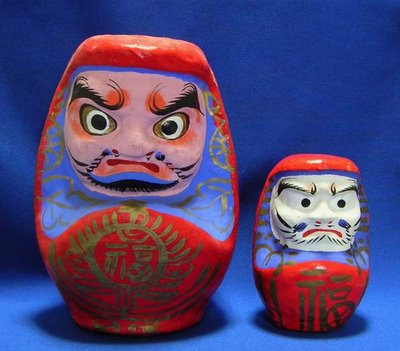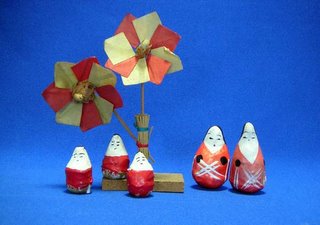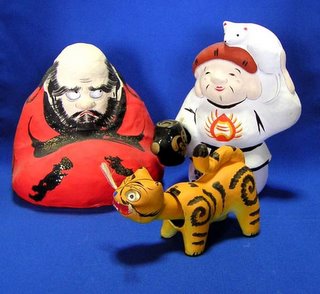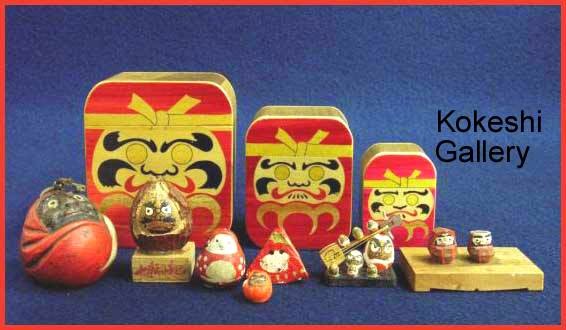:::::::::::::::::::::::::::::::::::::::::::::::::::::::::::::::::::::::::::::::::::::::::::::::::::::
Daruma with Beard - Hige Daruma
ひげだるま ひげ達磨
http://www.mproject21.com/ichironsan/
The Beard of Daruma was painted in the form of a snake (rather "Dragon"「蛇=龍」) in the beginning. Why did it change to a tortoise?
And why was it a snake in the beginning? And for what purpose did it change into a turtoise? And what about the combination with a crane? Maybe the tortoise is the painted version of the deformation of the snake's head and the scales?
Read the answer to these questions in my story about Crane, Tortoise and Good Luck
http://www.amie.or.jp/daruma/Tsurukame.html
:::::::::::::::::::::::::::::::::::::::::::::::::::::::::::::::::::::::::::::::::::::::::::::::::::::

This hand-crafted and painted Daruma figure was made in Shizuoka, Japan by a small Japanese family who specialize in the old style manufacture of these very unique dolls. The figures are created in the old family workshop where each doll is formed of papier-mache on a hand-carved wooden mold before being moved to an open air courtyard to dry and harden in the sun. The doll is then cut from the mold requiring yet another layer of wet papier-mache to seal the cut. Once more the figure is allowed to dry before being taken into the shop to be hand-painted red and flesh tone with dark black beard and eyebrows and golden body accents.
The only area of the doll left unpainted are the eyes in order that the person who buys the Daruma may use the unpainted eyes to help them achieve some important goal. Each doll is cleverly weighted on the bottom allowing Daruma to right himself when tipped. In an era when many traditional Japanese crafts are, in fact, mass produced outside Japan this very special Daruma represents a increasingly rare chance to acquire an authentic piece of Japanese culture made the old fashioned way, by a small family business operating near the foot of beautiful Mt. Fuji.
Detail of the Face

source : The Old Tokaido

More DARUMA from "The Old Tokaido"
:::::::::::::::::::::::::::::::::::::::::::::::::::::::::::::::::::::::::::::::::::::::::::::::::::::
Suzukawa Hige Daruma 鈴川 髭だるま

From Shizuoka、 Suzukawa village 鈴川村
:::::::::::::::::::::::::::::::::::::::::::::::::::::::::::::::::::::::::::::::::::::::::::::::::::::
Now for some Daruma Dolls famous for a beard made of real hair.
Hiratsuka Hige Daruma <> Bearded Daruma from Hiratsuka
Maybe the most famous Daruma doll of papermache (hariko) with a real beard was made in Hiratsuka. The store of Arai san keeps this tradition until today, you can even order it online. (I think the hair is made from horse hair.)
http://www.darumayahonpo.com/sakuhin/index.html
.........................................................................................................
Shizuoka Hige Daruma <> Bearded Daruma from Shizuoka Prefecture
On the following LINK about dolls from Shizuoka Prefecture, you can see our Daruma on the second picture somewhere in the middle, beside a little boy holding a red Daruma in front of him. The hair of this Daruma is made from real human hair. The first dolls of this kind where made by Sugimoto Kisuke round 1850 and are still produced now, by his 4th follower, at the store "Zawaya".
静岡張り子は、初代杉本嘉助が安政年間(1854~60)に開業以来代々張り続けられ、現代4代目の「沢屋」栄司さんがその伝統を受け継いで制作しています。
掲載の中央の「髭だるま」は、本物の髭がついています。
http://www.asahi-net.or.jp/~SA9S-HND/agal-937-1.html
.......................................................................................................
Tama Daruma from the Kanto Area

多摩だるまとして知られる、多摩地方の張り子は、江戸末期に起こり現在まで連綿と続いてきた伝統の郷土玩具で、現在でも四軒が制作しており、販路はもっぱら各地で開かれるだるま市などです。
写真の招きは会田家の物で、多摩張り子独特のひげ、眉毛の大胆で勢いのあるところが特徴といえます。
http://plaza.rakuten.co.jp/syouan/5002
.....................................................................................................
Matsumoto Daruma
Another famous Bearded Daruma doll comes from Matumoto city, Nagano Pref.
They are sold at many markets during the New Year Season. The Japanese word for "making money" MOOKE, sounds similar to the word for "hair" KE, so with this play of words a wish for making money and good business is handed over to Daruma to fulfill.

http://www.ginbura.com/shop/daruma/matsumoto.html
一般的な上州達磨はひげを墨で複雑に書くのに対し、染料によって黒く染められた麻を切って付け立体的に表現しているのが特徴で、その形態は全国唯一。この”毛”には「もうけ」の意を含み、また、頬のひげはエクボにちなんで丸く、家内円満との願いが込められている。 戦前は海外にまで輸出された「松本達磨」だが、現在では極めて貴重な文化の一つだ。
http://www.azm.janis.or.jp/azumi/fudoki/fudoki9704-gen.html
.............................................................................................................
On this page you can have a look at many Daruma dolls, some with a big painted beard.
For Example, Matsukawa Daruma

http://www.asahi-net.or.jp/~um8d-tmzk/darumasan2.htm
..............................................................................................................
Tamashima Daruma
Daruma dolls made in Tamashima, Okayama Prefecture, also feature quite a huge beard, although they do not fit in the official category of "Bearded Daruma". They are made in memory of the priest Ryookan, you can read more about it here in my Story:
http://www.amie.or.jp/daruma/Ryokan.html
:::::::::::::::::::::::::::::::::::::::::::::::::::::::::::::::::::::::::::::::::::::::::::::::::::::
Portraits of Daruma traditionally emphasized his 'Indian' appearance with bushy beard and eyebrows, compelling eyes, large nose and long ears (a symbol of Buddhist sanctity). He wears a large earring. The painting is powerfully executed in a variety of fine lines for the face, hair and beard and dashing black brushstrokes for the robes. This follows Chinese traditions of calligraphy (the art of writing with a brush).
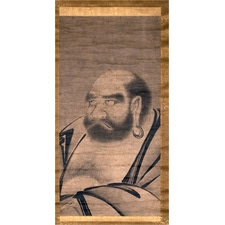
The painting is powerfully executed in a variety of fine lines for the face, hair and beard and dashing black brushstrokes for the robes. This follows Chinese traditions of calligraphy (the art of writing with a brush).
The painting is unsigned and a former attribution was to Sōami (around 1455-1525), ink painter and curator of art collections of the Ashikaga Shogunate (1338-1573). More recent scholarship suggests a date of the later sixteenth century.
© www.britishmuseum.org
:::::::::::::::::::::::::::::::::::::::::::::::::::::::::::::::::::::::::::::::::::::::::::::::::::::
.. .. .. A Manga-type Bearded Daruma
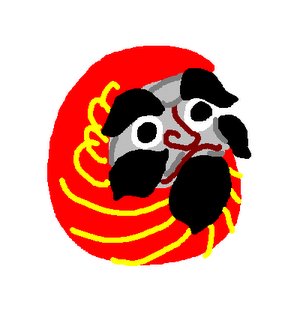
http://blog.kansai.com/mkg/80
xxxxxxxxxxxxxxxxxxxxxxxxxxxxxxxxxxxxxxxxxxxxxxxxxx
There is a woodworkers atelier in Saitama Prefecture called "BeardedDaruma".
Some of these things look very much like the ones my husband makes here.
木工房 ひげだるま
http://www.r-s-bear.com/gallery.htm
.............................................................................................
The tumbler dolls of papier-machee first made in Kyoto, soon reached the new capital of Edo. The inventive townspeople of Edo painted a big black beard on the face of the old man and a visiting priest came to say: "Well, if this is not the face of daruma daishi himself!" .
The red robe was the traditional garb of a priest.
© strangefortune.com/
:::::::::::::::::::::::::::::::::::::::::::::::::::::::::::::::::::::::::::::::::::::::::::::::::::::
For members of the Darum Forum only, here is another page with Hige Daruma.

rainy season --
Daruma's beard
becomes thick
Chibi
http://groups.yahoo.com/group/Darumasan-Japan/
:::::::::::::::::::::::::::::::::::::::::::::::::::::::::::::::::::::::::::::::::::::::::::::::::::::
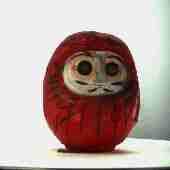
From Saitama Prefecture
埼玉県 入間郡 宮寺村 蚕祭ニテ
H20.2×W17.9×D17.3(cm) 205.8(g)
「屋根裏の博物館 ‐ 実業家渋沢敬三が育てた民の学問 ‐」展
oo oo

From Saitama Prefecture
埼玉県 入間郡 三ケ島村
H89.9×W79.7×D64.3(cm) 3330.0(g)
「屋根裏の博物館 ‐ 実業家渋沢敬三が育てた民の学問 ‐」展
More Hige Daruma on this page of Kodomobeya:
http://www.brico-art.com/date/kodomobeya.html
:::::::::::::::::::::::::::::::::::::::::::::::::::::::::::::::::::::::::::::::::::::::::::::::::::::::
Daruma with a white beard from Hachioji town, Tokyo

Inoue Takejiro 井上竹次郎 from Hachioji
八王子だるまと井上竹次郎
- source : www.choeisha.com
:::::::::::::::::::::::::::::::::::::::::::::::::::::::::::::::::::::::::::::::::::::::::::::::::::::
Taiwan produces a few art pieces made from the roots of bamboo.
Here is one of Daruma. 竹根 ひげ達磨

Click on the photo for original LINK.
:::::::::::::::::::::::::::::::::::::::::::::::::::::::::::::::::::::::::::::::::::::::::::::::::::::
H A I K U
Matsuo Basho, Thinking of Old Du Fu 憶老杜
髭風ヲ吹いて暮秋嘆ズルハ誰ガ子ゾ
hige kaze fuite boshuu tan zureba taga ko zo
his beard blown by the autumn wind
while he ponders the end of autumn -
who might he be ?
Matsuo Basho
. Du Fu. Tu Fu 杜甫 To Ho .
- - - - -
初雪に兎の皮の髭作れ
hatsu yuki ni usagi no kawa no hige tsukure
in the first snow
let's make beards
from rabbit fur
Tr. Barnhill
Written in 1689 元禄2年, Winter
while playing with children making a snowman in the mountains of his homeland 山中, Iga.
. Matsuo Basho 松尾芭蕉 - Archives of the WKD .
:::::::::::::::::::::::::::::::::::::::::::::::::::::::::::::::::::::::::::::::::::::::::::::::::::::::
Kobayashi Issa 小林一茶
髭どのに先こされけりはつ松魚
hige-dono ni saki kosarekeri hatsu-gatsuo
Lord Whiskers
is there first --
eating early bonito
Lord Puss Whiskers
already eating
early bonito
Kobayashi Issa
Comment by Chris Drake :
This is a spring hokku written in the 3rd month (April) of 1812, when Issa is traveling around in the area just east of Edo. Bonito, as skipjack tuna are usually called in Japanese-English dictionaries, are regarded as one of the most delicious fishes, and they were an expensive delicacy eaten both raw as sashimi and cooked. Bonito is a summer word, but this year the fish have appeared early, in spring, and people are lining up at restaurants and fish shops to buy the especially expensive and fresh early bonito. Lord Whiskers, however, is already eating his bonito before most people are able to get near one.
If the term refers to a human, it would probably to be to a fairly wealthy bearded commoner, such as a doctor or maybe a Confucian scholar, but in that case, why does Issa use "Lord"? If Lord Whiskers is a cat that acts like a lord and eats the remains of a delicious early bonito near a restaurant or fish market as if he were completely entitled to them, even though humans have to wait in line, then the hokku makes a lot of humorous sense. This reading is a guess, but it seems to be the best hypothesis. Robin Gill and Shinji Ogawa also seem to favor it.
The shogunate had outlawed beards for warriors, since it felt beards might serve as a symbol of rebellion, so Lord Whiskers is probably not a samurai lord, and aristocrats in Kyoto did not usually visit faraway Edo restaurants, so Lord Whiskers doesn't seem to refer to a member of the ruling class. Moreover, Issa has another hokku in which Lord Whiskers refers either to a commoner farmer or to the farmer's pet:
hige-dono no kuwa-kake-zakura sakinikeri
Lord Whiskers' cherry,
hoe leaning against it,
blossoms blooming
The tree against which the farmer rests his hoe and perhaps other farm implements has burst into bloom, and this normally utilitarian tree standing near the farmhouse has been transformed into an object of transcendent beauty. The reference to "Lord" Whiskers seems inappropriate for a farmer, however. It seems more likely that Issa is using the term to refer to the farmer's cat, which sits below the tree and the hoe in a way that shows he feels entitled to "his" favorite tree. This second hokku by Issa is the only one among several hokku in which Lord Whiskers appears that makes the cat interpretation a bit difficult. Still, I think it's quite possible to see a cat sitting under the cherry tree:
Lord Puss Whiskers
sits beneath a leaning hoe --
cherry tree in bloom
In the original text the ownership of the cherry tree and hoe isn't mentioned, and the owners can be different, so Issa may be suggesting that the cat is sitting under the tree with a lordly expression that suggests he considers himself to be the real owner. I'll try to translate some other hokku in which Lord Whiskers seems to be a cat.
Chris Drake
.............................................................................

source : Nakamura Sakuo
Tr. David Lanoue
. hatsu gatsuo 初鰹 first bonito (of the season) .
kigo for early summer
MORE
. Haiku with a beard .
:::::::::::::::::::::::::::::::::::::::::::::::::::::::::::::::::::::::::::::::::::::::::::::::::::::
. Folk Toys from Shizuoka .
[ . BACK to DARUMA MUSEUM TOP . ]
[ . BACK to WORLDKIGO . TOP . ]
:::::::::::::::::::::::::::::::::::::::::::::::::::::::::::::::::::::::::::::::::::::::::::::::::::::








